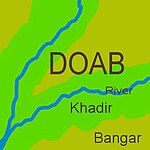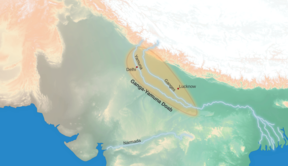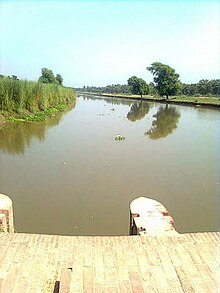Natural region in Indian subcontinent
| Doab | |
|---|---|
| Natural region | |
 A map showing the different doabs in the northern subcontinent A map showing the different doabs in the northern subcontinent | |
| Region | Indian subcontinent |
Doab (English: /ˈdoʊɑːb/) is a term used in South Asia for the tract of land lying between two confluent rivers. It is similar to an interfluve. In the Oxford Hindi-English Dictionary, R. S. McGregor defines it as from Persian do-āb (دوآب, literally "two water") "a region lying between and reaching to the confluence of two rivers."
Khadir, bangar, barani, nali and bagar
Main article: Khadir and Bangar See also: Bagar tract, Dhani, and Chak
Since North India and Pakistan are coursed by a multiplicity of Himalayan rivers that divide the plains into doabs (i.e. regions between two rivers), the Indo-Gangetic plains consist of alternating regions of river, khadir and bangar. The regions of the doabs near the rivers consist of low-lying, floodplains, but usually, very fertile khadir and the higher-lying land away from the rivers consist of bangar, less prone to flooding but also less fertile on average.
Khadir is also called nali or naili, specially in northern Haryana the fertile prairie tract between the Ghaggar river and the southern limits of the Saraswati channel depression in that gets flooded during the rains.
Within bangar area, the barani is any low rain area where the rain-fed dry farming is practiced, which nowadays are dependent on the tubewells for irrigation. Bagar tract, an example of barani land, is the dry sandy tract of land on the border of Rajasthan state adjoining the states of Haryana and Punjab. Nahri is any canal-irrigated land, for example, the Rangoi tract which is an area irrigated by the Rangoi channel/canal made for the purpose of carrying flood waters of Ghagghar river to dry areas.
Historically, villages in the doabs have been officially classified as khadir, khadir-bangar (i.e. mixed) or bangar for many centuries, and different agricultural tax rates applied based on a tiered land-productivity scale.
The Doab
The Doab Area depicting the Ganges-Yamuna Doab.
Area depicting the Ganges-Yamuna Doab. A 1908 map of the Doab, United Provinces
A 1908 map of the Doab, United Provinces
The Doab designates the flat alluvial tract between the Ganges and Yamuna rivers extending from the Sivalik Hills to the two rivers' confluence at Prayagraj. It is also called as Ganges-Yamuna Doab or Ganga Doab. The region has an area of about 23,360 square miles (60,500 square km); it is approximately 500 miles (805 km) in length and 60 miles (97 km) in width.
The British raj divided the Doab into three administrative districts, viz., Upper Doab (Meerut), Middle Doab (Agra) and Lower Doab (Allahabad).
Currently the following states and districts form part of The Doab:
Upper Doab
Saharanpur, Shamli, Muzaffarnagar, Baghpat, Meerut, Ghaziabad, Hapur, Gautam Buddh Nagar and Bulandshahr
Central or Middle Doab
Etah, Kasganj, Aligarh, Agra, Hathras, Firozabad, Mainpuri and Mathura is in the trans-Yamuna region of Braj.
Lower Doab
Farrukhabad, Kannauj, Etawah, Auraiya, Kanpur (Urban & Rural), Fatehpur, Kaushambi and Allahabad.
The Punjab Doabs

| Part of a series on |
| Punjabis |
|---|
 |
| History |
|
DiasporaAsia
Europe North America Oceania |
| Culture |
| Regions |
 Punjab portal |
Each of the tracts of land lying between the confluent rivers of the Punjab region of Pakistan and India has a distinct name, said to have been coined by Raja Todar Mal, a minister of the Mughal emperor Akbar. The names (except for "Indus Sagar") are a combination of the first letters, in the Persian alphabet, of the names of the rivers that bound the Doab. For example, "Chaj" (چج) = Chanāb (چناب, "Chenab") + Jehlam (جہلم, "Jhelum"). The names are from east to west.
Indus Sagar Doab
Main article: Indus Sagar DoabThe Indus Sagar Doab lies between the Indus and Jhelum rivers.
Chaj Doabs
Main article: Chaj DoabThe Chaj Doab lies between the Jhelum and the Chenab rivers.
Rachna Doabs
Main article: Rachna DoabThe Rachna Doab (considerable portion of the Rechna Doab is Majha) lies between the Chenab and the Ravi rivers.
Bari Doabs
See also: Bar RegionThe Bari Doab (considerable portion of the Bari Doab is Majha) lies between the Ravi, Beas and Sutlej rivers.
Bist Doab
Main article: Bist DoabThe Bist Doab (or Doaba) - between the Beas and the Sutlej rivers.
Other doabs
Raichur Doab
Main article: Raichur DoabThe Raichur Doab is the triangular region of Andhra Pradesh and Karnataka states which lies between the Krishna River and its tributary the Tungabhadra River, named for the town of Raichur.
See also
- Ap (water)
- Interamnia, an ancient Latin placename, meaning "between rivers"
- Mesopotamia, in Ancient Greek: Μεσοποταμία ' between rivers'.
Notes
- ^ doab or duab, n., OED Online, Oxford University Press, March 2014, retrieved 24 April 2019 Quote: "Originally and chiefly in South Asia: (the name of) a strip or narrow tract of land between two rivers; spec. (with) the area between the rivers Ganges and Jumna in northern India."
- doab or duab, n., OED Online, Oxford University Press, March 2014, retrieved 24 April 2019 Quote: "confluence, land between two rivers, used in India of the tongue of land between the Ganges and Jumna, and of similar tracts in the Punjab, etc., lit. ‘two waters’ "
- Doab., Webster's Third New International Dictionary, Unabridged., 2013, retrieved 24 April 2019 Quote: " a tract of land between two rivers : interfluve"
- Pakistan: Soils, Encyclopædia Britannica, 2010,
... khaddar soils. Away from the river, toward the middle of the doabs, older alluvial soils (called bangar) are widely distributed ...
- Damage to Yamuna Khadar, Ravi Shankar's Art of Living Responsible: NGT, Khas Khabar. 7 Dec 2017.
- ^ "The imperial gazeteers of India, 1908", British Raj, page 288.
- ^ E. Walter Coward, 1980, "Irrigation and Agricultural Development in Asia: Perspectives from the social sciences", Cornell University press, ISBN 0801498716.
- 1987, "gazetteer of India: Hisar District" Archived 1 May 2014 at the Wayback Machine, page 7.
- 1987, "Gazeteers of Hisar district, 1987" Archived 7 November 2017 at the Wayback Machine, Government of Haryana, page 162.]
- F.C. Channing (1882), Land Revenue Settlement of the Gurgaon District, Government of India,
... The rates here applied were the same as those applied in the Bangar and Khadar circles and the same comparisons hold good ...
- Oswald Wood, R. Maconachie (1882), Final report on the settlement of land revenue in the Delhi District, Government of India, 1882,
... The Khadar-Bangar chak lies along the river; 37 villages are purely Khadar and 39 partly Khadar partly Bangar. The villages nearest the river are subject to inundations, but where the water runs off in time, the natural fertility of the ...
- ^ Ganges-Yamuna Doab, Encyclopædia Britannica.
- "Archaeology Of Lower Ganga-Yamuna Doab 2 Volumes".
- ^ Kakshi, S.R.; Pathak, Rashmi; Pathak, S.R.Bakshi R. (2007-01-01). Punjab Through the Ages. Sarup & Sons. ISBN 978-81-7625-738-1. Retrieved 12 June 2010.
References
- McGregor, Ronald Stuart (1993), The Oxford Hindi-English Dictionary, Oxford University Press, p. 513, ISBN 978-0-19-864339-5, retrieved 11 September 2013
| Hydrography of Uttar Pradesh | |||||||
|---|---|---|---|---|---|---|---|
| Rivers |
| ||||||
| Lakes | |||||||
| Dams and barrages | |||||||
| Canals | |||||||
| Bridges | |||||||
| Related topics | |||||||
| Geography of South Asia | |||||||||
|---|---|---|---|---|---|---|---|---|---|
| Mountains |
| ||||||||
| Plateaus |
| ||||||||
| Deserts | |||||||||
| Lowlands |
| ||||||||
| Water-bodies |
| ||||||||
| Islands | |||||||||
| By country | |||||||||
| By region | |||||||||
| Historical regions of North India | |
|---|---|
| State of Uttarakhand | |||||||||||||||||||
|---|---|---|---|---|---|---|---|---|---|---|---|---|---|---|---|---|---|---|---|
| State capitals: legislative: Dehradun (winter); Bhararisain (summer); judicial: Nainital | |||||||||||||||||||
| Government |
| ||||||||||||||||||
| History |
| ||||||||||||||||||
| Geography and ecology |
| ||||||||||||||||||
| Demographics |
| ||||||||||||||||||
| Administrative divisions |
| ||||||||||||||||||
| Politics | |||||||||||||||||||
| Tourism |
| ||||||||||||||||||
| Sports | |||||||||||||||||||
| Other topics | |||||||||||||||||||
| Districts |
| ||||||||||||||||||
| Major cities | |||||||||||||||||||